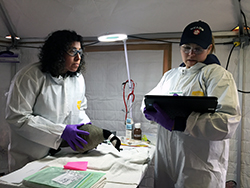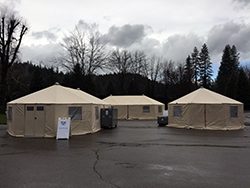

About 10 environmental scientists from CDFW’s Office of Spill Prevention and Response (OSPR) participated in a large-scale oil spill drill along the Feather River on March 21. The drill was intended to help wildlife response teams prepare for a potential train derailment. OSPR has a long history of oil spill response in marine environments but recently expanded its scope statewide to include inland waters. This Feather River exercise was the first time a substantial wildlife response drill has been held inland, testing responders’ abilities to resolve many operational and technical issues presented by a river spill.
Whereas marine spills typically require rescue of seabirds and occasionally marine mammals, the kinds of animals potentially affected by inland spills are quite different and varied, potentially including raptors, songbirds, reptiles, amphibians, rodents, foxes, and other mammals. The need to capture and care for these species during an oil spill presents unique challenges for scientist responders. The goal is to have the necessary protocols in place and practiced.
The drill was put on by the California Oiled Wildlife Care Network (OWCN), an organization funded by OSPR and managed by the UC Davis School of Veterinary Medicine to provide best achievable care of oiled wildlife. The OWCN currently maintains a network of 40 wildlife rehabilitation organizations, trained and ready to respond to oil spills anywhere in the state. Sixteen of these organizations participated in Tuesday’s drill, including two local organizations, Shasta Wildlife Rescue and Rehabilitation and North Valley Animal Disaster Group.
In addition to practicing wildlife response activities, the drill provided the opportunity to test a new Geographic Response Plan (GRP) for the Feather River. GRPs identify the location and nature of resources at risk in the event of a spill, and outline appropriate tactical response strategies to minimize oiling and other injury. During a real spill, OSPR environmental scientists serve as subject-matter experts who help ensure that the GRP is implemented appropriately. A simulated situation like this one gives them a valuable opportunity to conduct a realistic ‘dry run,’ as well as to analyze elements of the GRP and make adjustments as necessary.
To learn more about OSPR, visit www.wildlife.ca.gov/OSPR.